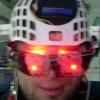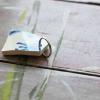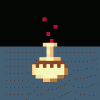Adverts help to support the work of this non-profit organisation. To go ad-free join as a Member.

tDCS thread
#91
Posted 09 March 2012 - 10:57 PM
I've also found the following:
There may have been cases where lab technicians have overused tDCS (over a period of years) on themselves and have possibly developed neurological or cognitive problems. There are also a few cases in the literature that describes several cases of bipolar depression converting to hypomania. This is in addition to the not uncommon burns and skin irritation.
* did have a source of this information a idind ecouter it yet
Chattanooga Ionto2
*did you have any specifications of thos device , i try google it tomorouw maybe you safe my time
----
electrodes i dount know tahts will work with my device
cout the currnet density of them and adjust the current if it needed the limit is about 60uA/cm2 for anode and cathode is best below 30 to minimalize the turn-off effects
#92
Posted 09 March 2012 - 11:00 PM
sponsored ad
#93
Posted 09 March 2012 - 11:17 PM
http://www.source1medical.com/Chattanooga-Iontophresis
https://www.medco-athletics.com/Supply/Product.asp?Leaf_Id=267765
As for the warning I posted about mental side-effects, as mentioned this is just something I'm relaying from a discussion group. If you wish I can e-mail you the link.
Edited by yowza, 09 March 2012 - 11:23 PM.
#94
Posted 09 March 2012 - 11:33 PM
in site i dout get this info i try it find elsewhere :
-how maximum stimulation voltage used
-max load
- its there interpended settins for each channel
As for the warning I posted about mental side-effects, as mentioned this is just something I'm relaying from a discussion group. If you wish I can e-mail you the link.
-yes please send
#95
Posted 10 March 2012 - 01:35 AM
As for your questions:
You could try calling the company or one of the 3rd party distributors I linked to earlier if you'd like. However, they'd probably get wary if they sense your not a physician and trying to use the device for offlabel purposes (even though from what I've seen it can be used so).
The company's official webpage has a pdf file you can download that can be found here:
http://www.chattgrou...n=1&cn=63&loc=3
I managed to find on the .pdf document that the current can be set in 0.1 mA increments between 0.5mA to 4mA. As it's an iontophoresis device the max current appears to be higher than normal. Currently, the accepted maximum current for human use is between 1 and 2mA (Found this additional info. on max tDCS voltage at a research supply site along with a lot of basic info. on how tDCS works here: http://www.rogue-resolutions.com/1298). One of the better aspects of this device is that there's a steady current and a display giving you the exact voltage reading (from which you may adjust as prescribed) though.
On a separate note, here's a getting started with tDCS video I just found (I know there's a lot of info. out there but this is an educational video that goes over the materials you'll need, head measurements, placement of electrodes, ect.). http://www.jove.com/...ent-stimulation
While it seems like one could get started pretty easy, I think the initial step before purchasing anything should be to have an EEG (to check for any spike or abnormal patterns that can be exacerbated while doing tDCS) to go along with a QEEG (to just assess background patterns compared to a normal database). If the person doesn't offer tDCS as part of their therapies, you could then ask for a disk of the raw EEG data plus ALL the QEEG picture reports on disc and send it out by mail to a 3rd party I suppose. This would help check for 1) indications vs. contraindications and 2) Specific type of protocol over what region.
Edited by yowza, 10 March 2012 - 01:39 AM.
#96
Posted 10 March 2012 - 11:46 AM
Trivarion ActivaDose Phoresor $245 http://www.isokineti...t/at_activadose
I have nothing to do with these companies. They came up in a google search after being recommended on a Neurotalk forum, as mentioned in a previous post.
#97
Posted 11 March 2012 - 05:57 PM
Here's a rough schematic. For reference I just put it on the same sheet as the Arduino pro mini schematic so you can see how the Arduino is powered. Omitted is the optional FTDI adapter for serial output to the PC. I have been using that to record the readings and calculate the current delivered, which may also be introducing some interference.
I do not see how your current sensing resistor can work as shown. I do not think you are properly referenced to ground, so your adc is seeing a much higher voltage.
I would removed all the other resistors and wiring around your current sensing resistor(s), and move just the current sensing resistor(s) to the extreme right side of your schematic between ground and the brain connection. Then your adc should be connected between the current sensing resistor and the brain connection. If your adc is differential, then connect the other lead to ground.
Hope this helps.
That did help. I added your comment to a separate thread I had going on at the hackerspace, and they pointed out that I had access to some differential amplifiers that would do a much simpler job at high side sensing. I'll have to change my code and reconstruct it, but in theory it sounds like it'll work. I'll report back in when I have results.
Thanks again.
#98
Posted 14 March 2012 - 04:56 PM
#99
Posted 14 March 2012 - 05:17 PM
#100
Posted 14 March 2012 - 06:46 PM
You won't be disappointed. It's better than any chemical substances and keeps you in focus.
Just wondering if you could post a photo of the device you've built + any schematics. Also, how'd you go about electrode positioning? Do you have some reference (like your nose or ears) for easy placement?
Regards.
#101
Posted 14 March 2012 - 07:08 PM
This is the scheme. It is so simple that does not require any photos. I used beer can foil and sponges around for electrodes. The scheme shows everything, just look at it. You need LM317T and two ceramic resistors. I am a little bald and the hair starts just after the DLPFC. I use it as indication of the position of the left electrode. If you draw two lines above the head and parallel to the floor from face to back of the head - one over and along the side of the head (left ear) and second along the center of the head - the required position of the left electrode will be between these two lines. So it is not on the side and not on the center of the head but somewhere between them.
#102
Posted 14 March 2012 - 07:16 PM
#103
Posted 14 March 2012 - 07:44 PM
#104
Posted 16 March 2012 - 03:06 AM
While it's for EEG, I suppose it could also be a good reference marker for tDCS as long as you knew the brain region your trying to target relative to one of the placements in the 10-20 system.
You could use either a small sticker (good for if there's some hair) or a china marker (tough to see this if you have a lot of hair) to mark the location you need before removing the brainet.
Keeping the hair parted can be tricky though.
Edited by yowza, 16 March 2012 - 03:09 AM.
#105
Posted 16 March 2012 - 07:29 PM
if this is a pictures of acutal device http://flowstateengaged.com/
then is in big trouble the electrodes for EKG is have absolutly wrong parametrs for tDCS like.
*electrolisis of hydrogel
*dangerously high current density
* to high resistance for 9Voperation
*cant be placed in hair
anode position its apear to low
i try to send him mail
#106
Posted 17 March 2012 - 05:43 PM
I am considering tcDCS to improve concentration (top-down attention), but it sounds risky, appreciate your experience You said iontophoresis device looks good but expensive, do you think it's worth it otherwise? If you do, I can try to buy & mail to you, in exchange for your experience
#107
Posted 17 March 2012 - 08:06 PM
intophoresis device is usabe for tDCS maybe wiill be need only different electrodes. Price of this device is high its best option for peoplle who cant build DIY tdcs.
For my is not use of it .I prefere to continute imporving DIY device the saftey is veri simmilar comerce one.In fure i need conection to PC and oteher features -intophoresisi device dout has this.
Next problem is time a have many other projects TDCS is only small part of it. I dout use TDCS very ofen i prefere to use mental technigues the effect is veri similar.
curent source is the simplest thing in TDCS much larger problems is electrodes and usage .Currently i prepare some info about bulding and safety.
---------
electrodes -i used aluminum bercan foil in sponges its not ideal can be ther ion trasfer to the brain i dout know how large, sponge may have prevnet this (act like membrane ).Its better to use stainless steal or carbon.
If aonyone have info about iont tranfer trouhgt songes/safery please send.
#108
Posted 17 March 2012 - 08:10 PM
Maybe its a simplest posible current regulative circut for tDCS.
#109
Posted 17 March 2012 - 08:46 PM
Sure.hi and very thanks fo the offer
For my is not use of it .I prefere to continute imporving DIY device the saftey is veri simmilar comerce one.In fure i need conection to PC
You want automatic feedback to adjust the current?
Currently i prepare some info about bulding and safety.
That would be great!
#110
Posted 17 March 2012 - 09:07 PM
No current is stable , i can adjust it manualy if it nedet and mesure it in multimeter during a stimulation
I need PC fom my expediment with inducting lucid dreamming ,i need trurn on tdcs in REM sleep.
I future pane use feedbcak with CES and EEG ,but need more info about this
I have crazy idea record brainwaves in state of mind and after put it back with stimulation device and use as EEG feedback to adjust stimulation parametres.
In therody inducted evoked potencilas can cuse brain to tune into this and induce similar sate of mind like recording.
This a only idea with many posible problems like induce epileptic sizure disrup natural brainwave pattern , fried part of brain.Few things i figured our but need more reserch .
fMRI wiil be help but this few milions out of budeget
#111
Posted 18 March 2012 - 02:47 AM
I need PC fom my expediment with inducting lucid dreamming ,i need trurn on tdcs in REM sleep.
That will probably wake you up, I think even a day-time stimulation can mess up your sleep?
I have crazy idea record brainwaves in state of mind and after put it back with stimulation device and use as EEG feedback to adjust stimulation parametres. In therody inducted evoked potencilas can cuse brain to tune into this and induce similar sate of mind like recording.
Right, generating brainwaves could give you more "subject-specific" stimulation, but I think pracitical recording & reproduction will only give you an average of large band of waves. Actually effective waves are generated by & transmitted to specific neurons, I don't know if you can get similar effect at so much lower resolution.
#112
Posted 18 March 2012 - 11:42 AM
Not necessarily. at the right level of stimulation it could just kick up consciousness up in the dream .
Mutisenzoric integration of dream senses should partially block awakening.Main dfference in dream and lucid dream is activation of DLPFC.
Stimulation during a dy its have effect to but smaller.
I know only one study about tDCS in sleep (NREM) imporving memory consolidation.
Right, generating brainwaves could give you more "subject-specific" stimulation, but I think pracitical recording & reproduction will only give you an average of large band of waves. Actually effective waves are generated by & transmitted to specific neurons, I don't know if you can get similar effect at so much lower resolution.
I aware of that and know limitations in EEG is lot of noise and waves of large part of brain but should be posible get part of cortex to specific frequenci band maybe something more.
Next otion is usage of mastoid montage and signals from deep parts of brain/neurons this isa specific waves firing patterns but there is a porblem with feedback EEG measure only cortex .
Also is there many otions how to get signal to the brain : light, audio,electrical , ultrasound,magnetic . It may not necessarily stimulate the brain directly, it should be possible to use TENS for example on the hand and watch the activity in the sensory kortex of thats part of the body,with a combination TDCS it could amplify effects.
#113
Posted 18 March 2012 - 01:48 PM
Mutisenzoric integration of dream senses should partially block awakening.Main dfference in dream and lucid dream is activation of DLPFC.
Do you mean that only primary cortices wake you up? That sounds plausible, do you have any references?
DLPFC is definitely a key area, but I wonder if it's just "the first among equals" for association cortices.
Stimulation during a dy its have effect to but smaller.
I think sleep activity is secondary, if you focus on right things during day, you will eventually start "replaying" it in your sleep anyway. It's so much more practical
I know only one study about tDCS in sleep (NREM) imporving memory consolidation.
That's strange, I thought NREM has mainly anabolic functions, how would tDCS affect that?
I aware of that and know limitations in EEG is lot of noise and waves of large part of brain but should be posible get part of cortex to specific frequenci band maybe something more.
I don't think stimulation needs to be that specific, the content of your computer screen can do a better job, if you design it right & use tDCS to actually focus on it
Next otion is usage of mastoid montage and signals from deep parts of brain/neurons this isa specific waves firing patterns but there is a porblem with feedback EEG measure only cortex .
You probably don't want to mess with thalamus & brainstem anyway, - might not wake up one day
Also is there many otions how to get signal to the brain : light, audio,electrical , ultrasound,magnetic . It may not necessarily stimulate the brain directly, it should be possible to use TENS for example on the hand and watch the activity in the sensory kortex of thats part of the body,with a combination TDCS it could amplify effects.
Right, but I think the signal is the easy part, real problem is paying attention to it
#114
Posted 18 March 2012 - 02:28 PM
DLPFC is definitely a key area, but I wonder if it's just "the first among equals" for association cortices.
The waking is very complex proces involving whole brain , chanchig levels of nerostasmiters modulation.
Use TDCS in REM its only a idea noone didt try that.Some divice like novadreamer nad other use flashing light or sound to induce lucid dreming it based on sugestion and serching for sign like ligithing induceed by flasehs of light main problem with this method is taht use physical senses if it strong enought this signal disrupt multisensoty ingeratin tahs hold dream word togeter.Main problem to induce lucid dream by DILD techniqe (in sleep) is lack of wakefullnes in dreams , moust method working on that during a day to inprove wakefullnes during the day the DLPFC is after this more activeted in REM ans lucid dreaming is easier.
Next method for LD is inducting it directly from waking state trought hypnagogic state this method show importatnce of mutisensory ingretin to stability of dream body and word.Fist step is turn off physical sences and crete space in data strem for nonphysical ones (dreams,visulization). If it nonpysical srong enought the create a dream body in this tshe you may encouter many strange thing if signals is equaly stron you may presive 2bodyes and various sensory ilusions (brain is trying ingrate 2 set of sences to body image its posible all combinations).Next otion to get to LD is after awakening ,sensory pathways reativation take few seconds if zy in this tibe focut to nonphysical sences and cretae drem body they fill whole data stream and you be awake in the dream.There is many posible porblems any of this situation haev differn propertis depens of chngig of neroumodultion like aminergic to colinergis, turnig of sences...
I think sleep activity is secondary, if you focus on right things during day, you will eventually start "replaying" it in your sleep anyway. It's so much more practical
Replayeyn is not much effective its a only a part you may create the rutine to test drem reality but importatnt thing is have enought wakefulness in strat to realize the result of the test.
That's strange, I thought NREM has mainly anabolic functions, how would tDCS affect that?
I must find a study but i thing in NREM is information from hypocampus sending to coretex. I also exist NREM dreams but have a differnt porpertios from normal ones.
I don't think stimulation needs to be that specific, the content of your computer screen can do a better job, if you design it right & use tDCS to actually focus on it
I depend waht part of brain you can stimulate itsmany posibilities like use the screen and TDCS to part of cortex to enhaced a lernig poroces by LTP.Visial stimuls is good but nor for all aplications is there more effective ways.
You probably don't want to mess with thalamus & brainstem anyway, - might not wake up one day
I know the risk stop hatr or brething is one of posible bad result. This is only ideas i dout intend to test it until I have the necessary information.In this time a prefere try to influencicg this part by mental techniges and audie stimulation .
Right, but I think the signal is the easy part, real problem is paying attention to it
It works without attention ,ofcource with it would be better.
#115
Posted 18 March 2012 - 03:55 PM
I depend waht part of brain you can stimulate itsmany posibilities like use the screen and TDCS to part of cortex to enhaced a lernig poroces by LTP.Visial stimuls is good but nor for all aplications is there more effective ways.
Right, I only want to stimulate attention to abstract stuff: text & code. I think we humans care way too much about sensory things as it is
#116
Posted 20 March 2012 - 08:06 PM
Transcranial Electrical Currents to Probe EEG Brain Rhythms and Memory Consolidation during Sleep in Humans
Previously the application of a weak electric anodal current oscillating with a frequency of the sleep slow oscillation (∼0.75 Hz) during non-rapid eye movement sleep (NonREM) sleep boosted endogenous slow oscillation activity and enhanced sleep-associated memory consolidation. The slow oscillations occurring during NonREM sleep and theta oscillations present during REM sleep have been considered of critical relevance for memory formation. Here transcranial direct current stimulation (tDCS) oscillating at 5 Hz, i.e., within the theta frequency range (theta-tDCS) is applied during NonREM and REM sleep. Theta-tDCS during NonREM sleep produced a global decrease in slow oscillatory activity conjoint with a local reduction of frontal slow EEG spindle power (8–12 Hz) and a decrement in consolidation of declarative memory, underlining the relevance of these cortical oscillations for sleep-dependent memory consolidation. In contrast, during REM sleep theta-tDCS appears to increase global gamma (25–45 Hz) activity, indicating a clear brain state-dependency of theta-tDCS. More generally, results demonstrate the suitability of oscillating-tDCS as a tool to analyze functions of endogenous EEG rhythms and underlying endogenous electric fields as well as the interactions between EEG rhythms of different frequencies
#117
Posted 27 March 2012 - 02:44 AM
Hi everybody,
I have simulated a constant current source circuit (which I found on-line)on circuit labs website. Anybody who wants to play with it before you build your own can do so by clicking the below link. Very useful site to test simulated circuits.
Any suggestions for improvement welcome. I am an electronics newbie but I managed to do it although it took me nearly 10 hours of work to finally get it working.I hope others will simulate their own designs. Enjoy.
https://www.circuitl...-source-0-4-ma/
#118
Posted 11 April 2012 - 08:09 AM
Introduction to transcranial Direct Current Stimulation Course, March 17, 2011 tDCS Dose (and how models can help) Marom Bikson+slides
http://bme.engr.ccny...ntDCScourse.pdf
https://clinicalrese...e&pbMode=normal
---------
6.4 Test of EKG elctrodes resistance With my multimettr is imposible mesure it directly so must measure volatge nad current and count the resitaence.
I test it in my 18V tDCS
EKG electrode S = 3,14 cm2
worst case scenarios
1. 2times resused EKG electrode and no skin prepation - in mastoid pacement
I=100uA U=17,75V I=32uA/cm2 R=200kOhm feeling - nothing
I=50uA U=17,75V I=16uA/cm2 R=355kOhm feeling - nothing
1. New elctrodes + skin preparation(wash,degreased ,slight abrasion,slght wet) DLPFC placement I=2,6mA I=826uA/cm2 R=below 7kOhm device be setup for 2,6mA current density be pretty high turn it off right after I read data senstation -twitching muscele and strong fosfen in start slight burning sensation. Effects slight mood imporvement ,no rednnes in the skin.
------------
currently i working on some new info about effect of DC field orintation to the neurones and other interesting suff update soon
#119
Posted 11 April 2012 - 10:38 AM
after reading some new info i decide to imropove focality of stimulation, and make in more precize.But there is a poroblem is too much reading to do this alone.
Should anyone interested to join and get DIY tDCS to next level?
with what I need help:
Find all stimulation protocols of DLPFC (F3) nad write info about it :
name of study:
stimulation parameters: duration, current density (on electrode and cortex),electrode material , placement
effect: described , placebo ,cathodal,anodal..
subjects :healty or ill (what illnes)
(in some multistudy it can be all tohether)
sponsored ad
#120
Posted 12 April 2012 - 07:32 PM
or nifty hippie eco version
photovoltaic tDCS
USB 5v to super bright LED => to about 7 photovoltaics series with a resistor to create measured 9v 1mA regardless of what software is doing you see light is on, so power output is grouped photovoltaic output, always mild range at right polarity, build it right (photovoltaics available to sunlight) you can be smart off the grid as well
All Electronics has this photovoltaic at $3.75, http://www.allelectr...0MM-X2MM/1.html three of them lit up would provide 9v 40 mA so just add the superbright LED, a resistor or potentiometer to create the 1 or 2 mA
The USB version could of course link an onscreen stimulus to the LEDs being lit up if varied stimulus is of benefit
digi key has these parts http://search.digike...?k=photovoltaic
Edited by treonsverdery, 12 April 2012 - 07:35 PM.
2 user(s) are reading this topic
0 members, 2 guests, 0 anonymous users














































